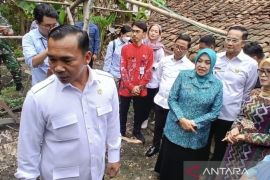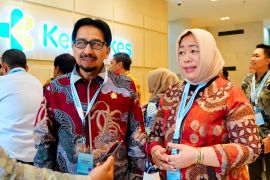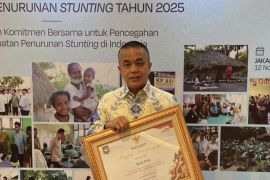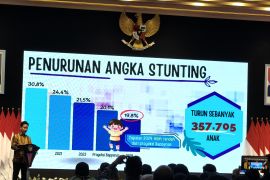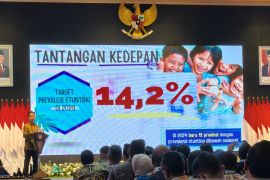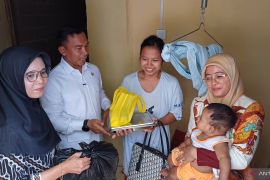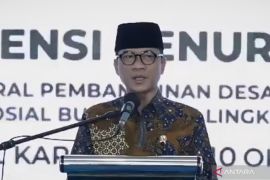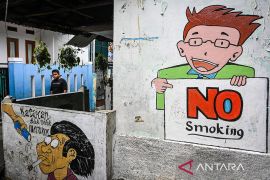Asfahany recalled that when she started giving her complementary food after six months of exclusive breastfeeding, Khaulah seemed less interested in food and did not have a good appetite, which led to problems with her weight.
From the time Khaulah was eight months old until she reached the age of two, her weight did not increase and remained stagnant at about eight kilograms.
Based on the anthropometric standard issued by the Ministry of Health, a 24-month-old girl should weigh more than nine kilograms. Based on this, Khaulah was categorized as malnourished and stunted.
Asfahany understood that stunting would be a big problem for her daughter: A girl who is stunted is at risk of giving birth to a stunted child later, thereby fueling a vicious cycle.
This is because when stunted children become teenagers, they can experience malnutrition or anemia due to iron deficiency. When stunted girls become mothers, they tend to give birth to babies with low birth weights, which puts them at risk of stunting.
Therefore, Asfahany said she wanted the chain of stunting to be broken immediately, starting with her daughter.
Apart from its long-term impact, in the short term, stunting can cause children to fall sick easily and experience health problems. Stunted children also experience less optimal cognitive, motor, and verbal development compared to their peers.
The impact of stunting does not only show when a child is still under 5, but it can also be seen in their learning at school.
Asfahany understood that even though her daughter was active and cheerful, it did not mean she was free of stunting. Therefore, she started her struggle to get Khaulah out of the stunted category by getting her checked by a pediatrician.
Nasogastric tube therapy
Asfahany's struggle to improve Khaulah's nutrition was not easy. After getting her checked for stunting, the doctor referred Khaulah for a Mantoux test and a blood test.
After a series of tests and consultations with a number of pediatricians, it was finally discovered that Khaulah had tuberculosis (TB) and iron deficiency anemia (ADB).
Asfahany regretted not having detected the symptoms sooner so that treatment could be started earlier.
TB and ADB are silent diseases that the naked eye cannot see. Children who have TB and ADB may look fine and carry on activities normally.
Despite months of TB treatment, Khaulah's weight did not increase significantly.
Finally, the fifth doctor that Asfahany met suggested that Khaulah consume nutritious milk through a nasogastric tube.
The 24-month-old child then had a tube inserted through her nose into her stomach because she couldn't consume the milk through her mouth.
Each day, Khaulah had to consume at least four bottles or 800 milliliters of the special milk. Indeed, the therapy, which was aimed at increasing the child's weight, was not cheap with 1 bottle of milk costing Rp30 thousand (around US$1.97).
Asfahany and her husband ended up spending up to Rp3.5 million (around US$230.36) over one month for the treatment.
After a month of therapy, Khaulah's weight increased by one kilogram to nine kilograms.
What's On My Plate guide
Dicky Iskandar, a pediatrician at Bunda Public Hospital Jakarta, emphasized that stunting can be prevented before the first 1,000 days of a child's life end. The first 1,000 days start while they are still in the womb and extend until they are two years old, the pediatrician added.
After a stunted child turns two, parents need to work hard to improve their condition because the golden period of children's brain development is the first 1,000 days of life. Once they turn two years old, their brain weight reaches 75 percent of the weight of an adult's brain.
According to Iskandar, the only solution to stunting is paying attention to the Isi Piringku (What's On My Plate) guide, which includes tips such as providing animal proteins to children.
Parents have a role in providing a balanced diet consisting of carbohydrates, animal proteins, some vegetable proteins, and sufficient quantities of fruits and vegetables to children.
If a child is already at risk of stunting, an intervention can be made by adding animal proteins so that the food that they consume can be made rich in nutrients and high in calories.
Nutritionist Tan Shot Yen emphasized that the concept of What's On My Plate promoted by the Ministry of Health is actually not specifically aimed at children alone, but can be a habit inculcated by parents, which they can later apply to children.
If during pregnancy, pregnant women comply with the guide, the weight of the fetus will increase because protein intake is needed by the fetus.
Mothers are also being encouraged to use the guide when planning the complementary food menu. They can also adjust the menu for their children's complementary food depending on the family's food habits.
Besides mothers' nutritional status, attention also needs to be paid to babies to ensure early initiation of breastfeeding that can make it easier for mothers to exclusively breastfeed their children for 6 months and continue it for up to two years.
Amid efforts to prepare the 2045 golden generation that will have quality and competent human resources, stunting has been the main concern for President Joko Widodo.
According to the 2022 Indonesian Nutritional Status Survey (SSGI), Indonesia’s stunting prevalence declined by 2.8 percentage points to 21.6 percent in 2022 from 24.4 percent in 2021. The government is aiming to reduce stunting prevalence to 14 percent by 2024.
In efforts to tackle stunting, parents remain at the vanguard in participating in handling and preventing stunting cases.
Awareness and information about stunting is the starting point for parents to build a smart and competent generation. Parents can visit integrated health posts (posyandus) to get their child's weight and height measured to check whether their growth and development are on the right track.
The widespread information and the availability of posyandu facilities that provide additional food should be utilized to prevent nutritional problems in children.
Related news: BKKBN, PPM collaborate to reduce stunting through education, CSR
Related news: BKKBN head urges academicians to use family data in research
Editor: Rahmad Nasution
Copyright © ANTARA 2023


